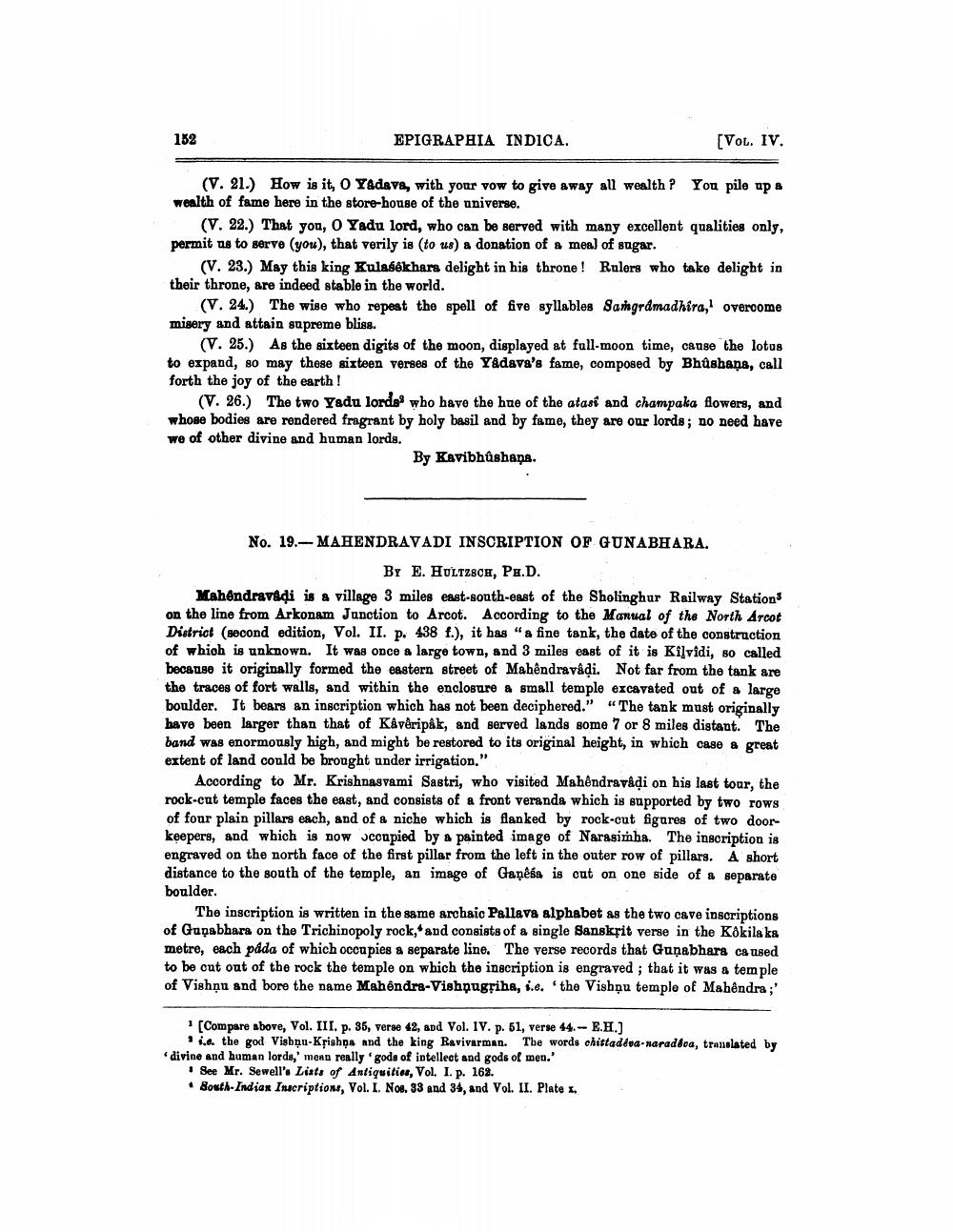________________
152
EPIGRAPHIA INDICA.
[Vol. IV.
(V. 21.) How is it, O Yadave, with your vow to give away all wealth? You pile up & wealth of fame here in the store-house of the universe.
(V. 22.) That you, O Yadu lord, who can be served with many excellent qualities only, permit us to serve (you), that verily is (to us) a donation of a meal of sugar.
(V. 23.) May this king Kulagokhara delight in his throne ! Rulers who take delight in their throne, are indeed stable in the world.
(V. 24.) The wise who repeat the spell of five syllables Sangrdmadhira, overcome misery and attain supreme bliss.
(V. 25.) As the sixteen digits of the moon, displayed at full-moon time, cause the lotus to expand, so may these sixteen verses of the Y&dava's fame, composed by Bhushana, call forth the joy of the earth!
(V. 26.) The two Yadu lords who have the hue of the atasi and champaka flowers, and whose bodies are rendered fragrant by holy basil and by fame, they are our lords; no need have we of other divine and human lords.
By Kavibhushaņa.
No. 19.-- MAHENDRAVADI INSCRIPTION OF GUNABHARA.
By E. Hultzsce, Pa.D. Mahendravidi is a village 3 miles east-south-east of the Sholinghur Railway Stations on the line from Arkonam Junction to Arcot. According to the Manual of the North Arcot District (second edition, Vol. II. p. 438 f.), it has "a fine tank, the date of the construction of which is unknown. It was once a large town, and 3 miles east of it is Kilvidi, so called because it originally formed the eastern street of Mahendravådi. Not far from the tank are the traces of fort walls, and within the enclosure a small temple excavated out of a large boulder. It bears an inscription which has not been deciphered." "The tank must originally have been larger than that of Kåveripåk, and served lands some 7 or 8 miles distant. The band was enormously high, and might be restored to its original height, in which case a great extent of land could be brought under irrigation."
According to Mr. Krishnasvami Sastri, who visited Mahendrapadi on his last tour, the rock-cut temple faces the east, and consists of a front veranda which is supported by two rows of four plain pillars each, and of a niche which is flanked by rock-cut figures of two doorkeepers, and which is now occupied by a painted image of Narasimha. The inscription is engraved on the north face of the first pillar from the left in the outer row of pillars. A short distance to the south of the temple, an image of Ganesa is out on one side of a separate boulder.
The inscription is written in the same archaic Pallava alphabet as the two cave inscriptions of Guņabhara on the Trichinopoly rock, and consists of a single Sanskrit verse in the Kokila ka metre, each půda of which occupies a separate line. The verse records that Guņabhara caused to be cut out of the rock the temple on which the inscription is engraved ; that it was a temple of Vishņu and bore the name Mahendra-Vishnugfiha, i.e. the Vishnu temple of Mahendra ;'
[Compare above, Vol. III. p. 86, verse 42, and Vol. IV. p. 51, verse 44.-E.H.) 11.o the god VishnuKrishna and the king Ravivarman. The words chittadeva-naraddva, translated by divine and human lords,' mean really gods of intellect and gods of men.'
• See Mr. Sewell's Lists of Antiquities, Vol. I. p. 162. • South Indian Inscriptions, Vol. I. Nos. 33 and 34, and Vol. II. Plate ,




